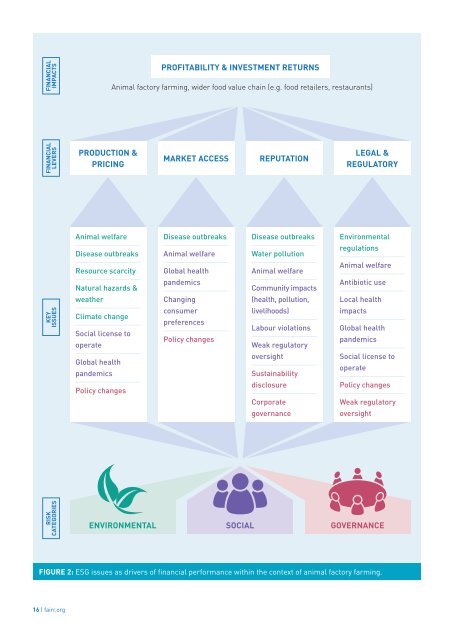FACTORY FARMING
1M2uJRn
1M2uJRn
You also want an ePaper? Increase the reach of your titles
YUMPU automatically turns print PDFs into web optimized ePapers that Google loves.
FINANCIAL<br />
IMPACTS<br />
FINANCIAL<br />
LEVERS<br />
PRODUCTION &<br />
PRICING<br />
PROFITABILITY & INVESTMENT RETURNS<br />
Animal factory farming, wider food value chain (e.g. food retailers, restaurants)<br />
MARKET ACCESS<br />
REPUTATION<br />
LEGAL &<br />
REGULATORY<br />
Definitions<br />
Relationship between ESG issues and their impacts on financial outcome.<br />
••<br />
Production and price: refers to the impacts on production, which are determined largely by weather<br />
conditions and disease. Price risk refers to changes in the prices of inputs and outputs and is generally<br />
external to production processes.<br />
••<br />
Market access: refers to the ability of producers to sell to different markets, including national markets<br />
and specific customers (such as government bodies and private sector firms).<br />
••<br />
Reputation: refers to the damage done to a company’s reputation or brand.<br />
••<br />
Legal and regulatory: refers to the financial impact that may arise from changes in laws and<br />
regulations or from violations of existing laws and regulations.<br />
KEY<br />
ISSUES<br />
RISK<br />
CATEGORIES<br />
Animal welfare<br />
Disease outbreaks<br />
Resource scarcity<br />
Natural hazards &<br />
weather<br />
Climate change<br />
Social license to<br />
operate<br />
Global health<br />
pandemics<br />
Policy changes<br />
Disease outbreaks<br />
Animal welfare<br />
Global health<br />
pandemics<br />
Changing<br />
consumer<br />
preferences<br />
Policy changes<br />
Disease outbreaks<br />
Water pollution<br />
Animal welfare<br />
Community impacts<br />
(health, pollution,<br />
livelihoods)<br />
Labour violations<br />
Weak regulatory<br />
oversight<br />
Sustainability<br />
disclosure<br />
Corporate<br />
governance<br />
Environmental<br />
regulations<br />
Animal welfare<br />
Antibiotic use<br />
Local health<br />
impacts<br />
Global health<br />
pandemics<br />
Social license to<br />
operate<br />
Policy changes<br />
Weak regulatory<br />
oversight<br />
ENVIRONMENTAL SOCIAL GOVERNANCE<br />
FIGURE 2: ESG issues as drivers of financial performance within the context of animal factory farming.<br />
2.3 ENVIRONMENTAL<br />
ISSUES AND IMPACTS<br />
13 environmental issues impact the animal factory<br />
farming industry<br />
Environmental issues are the most quantifiably<br />
material of ESG issues<br />
Legal and regulatory impacts are the most<br />
common ‘E’ issue<br />
Long term production risks due to environmental<br />
factors are likely to be highly material<br />
ENVIRONMENTAL ISSUES CAN IMPACT ALL<br />
FOUR FINANCIAL LEVERS: PRODUCTION AND<br />
PRICING, MARKET ACCESS, REPUTATION<br />
AND LEGAL & REGULATORY<br />
The animal factory farming industry can cause<br />
environmental harm but it can also be negatively<br />
affected by environmental factors. Firstly, animal<br />
factory farming can cause significant damage to the<br />
local and global environment, through for example,<br />
water pollution, greenhouse gas emissions and<br />
deforestation – the latter either directly through land<br />
conversion for farms or indirectly through the clearing<br />
of land for feed production. These characteristics are<br />
key drivers of legal and regulatory risks for the industry.<br />
Secondly, animal factory farming is highly vulnerable to<br />
harm caused by environmental factors. Individual farms,<br />
companies and the industry as a whole can suffer as a<br />
result of natural hazards, adverse weather conditions,<br />
animal disease, resource scarcity (including access to<br />
water and land) and climate change. These types of<br />
events have a strong bearing on changes to production<br />
and the price of inputs and outputs, particularly feed.<br />
In contrast, conventional, pasture-based livestock<br />
operations are less reliant on imported feed.<br />
LEGAL AND REGULATORY ISSUES ARE<br />
KEY DRIVERS OF FINANCIAL RISK<br />
Legal and regulatory impacts are the most frequent<br />
consequence of environmental issues, associated with<br />
11 out of the 13 identified issues. With respect to legal<br />
and regulatory levers, there are numerous examples of<br />
farms being penalised for violations of environmental laws.<br />
For example, following a 500,000-gallon manure spill in<br />
2008, the 1,000-cow dairy operation at Teabow Farms,<br />
Maryland, was forced to reimburse the town of Walkersville<br />
and Frederick County for providing emergency water<br />
supplies, testing and other costs. 37<br />
Given the significant harm to the environment caused<br />
by animal factory farming (e.g. water pollution), the<br />
industry as a whole is highly regulated in developed and<br />
developing countries. Therefore, violations of national<br />
environmental laws and regulations can result in heavy<br />
fines and other types of penalties. For example, in 1997<br />
US-based pork producer Smithfield Foods was fined<br />
US$12.6 million for violating the Clean Water Act.<br />
THE INDUSTRY IS HIGHLY VULNERABLE<br />
TO THE COMBINATION OF INCREASINGLY<br />
DEMANDING ANIMAL WELFARE STANDARDS<br />
AND THE GROWING BODY OF STRINGENT<br />
ENVIRONMENTAL LAWS.<br />
There is a clear trend towards the introduction of more<br />
stringent environmental regulations in both developed<br />
and developing countries. This is occurring alongside<br />
16 | fairr.org fairr.org | 17


